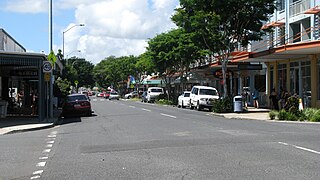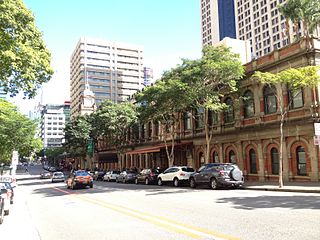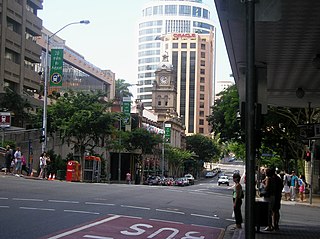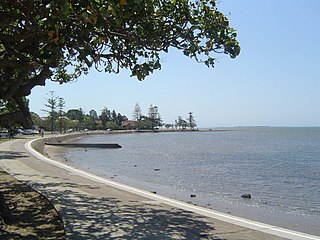
Chateau Nous is a heritage-listed villa at 1 Rupert Terrace, Ascot, Queensland, Australia. It was designed by Douglas Francis Woodcraft Roberts and built from c. 1937 to 1940s. It was added to the Queensland Heritage Register on 21 October 1992.

Ithaca Fire Station is a heritage-listed fire station at 140 Enoggera Terrace, Paddington, Queensland, Australia. It was designed by station superintendent Alfred Joseph Harper and built in 1918-1919; an upper level was designed by Atkinson, Powell and Conrad and built by Frederick Enchelmaier in 1928. It was added to the Queensland Heritage Register on 2 March 1993.

Yeronga Fire Station is a heritage-listed former fire station at 785 Ipswich Road, Yeronga, City of Brisbane, Queensland, Australia. It was designed by architectural firm Atkinson and Conrad, and built in 1934 by contractor William Allen Miller. It is a two-storey timber structure adjacent to Yeronga Park, and originally housed the station facilities on the ground floor and a residence for the superintendent on the first floor, a combination typical for Brisbane fire stations of this era.

Scott Street Flats is a heritage-listed apartment block at 2 Scott Street, Kangaroo Point, City of Brisbane, Queensland, Australia. It was designed by Elina Mottram and built to c. 1925 by W B Johnstone. It is also known as Scott House. It was added to the Queensland Heritage Register on 29 April 2003.

Chelmer Police College is a heritage-listed former police barracks at 17 Laurel Avenue, Chelmer, City of Brisbane, Queensland, Australia. It was built from 1900 to 1970. It is also known as 10 WRAAC Barracks, The Lady Wilson Red Cross Convalescent Home, and Waterton. It was added to the Queensland Heritage Register on 1 October 2003.
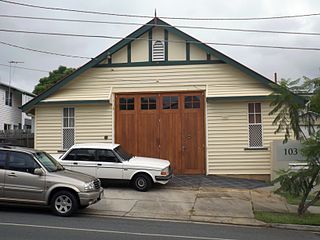
Balmoral Fire Station is a heritage-listed fire station at 105 Pashen Street, Morningside, Queensland, Australia. It was designed by architects Atkinson and Conrad and built from c. 1926 to 1929 by C. King. It was added to the Queensland Heritage Register on 26 November 1999.

Shafston House is a heritage-listed villa at 23 Castlebar Street, Kangaroo Point, Queensland, Australia. It was designed by Robin Dods and built from 1851 to 1930s. It is also known as Anzac Hostel, Ravenscott, and Shafston International College. It was added to the Queensland Heritage Register on 7 February 2005.

Wynnum Ambulance Station is a heritage-listed museum and former ambulance station at 33 Tingal Road, Wynnum, City of Brisbane, Queensland, Australia. It was built from 1926 to 1927. It is also known as the Queensland Ambulance Museum and the QATB Station. It was added to the Queensland Heritage Register on 26 March 1999. It is open by appointment.
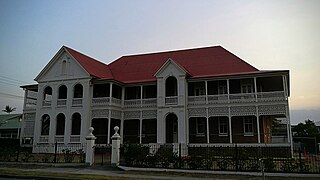
Mount Carmel Convent is a heritage-listed former Roman Catholic convent at 199 Bay Terrace, Wynnum, City of Brisbane, Queensland, Australia. It was designed by Hall & Dods and built in 1915 by William Richard Juster. It was added to the Queensland Heritage Register on 27 August 1999.

Nazareth House is a heritage-listed benevolent institution at 272 Wynnum North Road, Wynnum, City of Brisbane, Queensland, Australia. It was built from 1924 to 1939. It was added to the Queensland Heritage Register on 2 April 2002.

The Michael Gannon residence is a heritage-listed holiday home at 150 Kingsley Terrace, Manly, City of Brisbane, Queensland, Australia. It was built c. 1888. It was added to the Queensland Heritage Register on 27 October 2000.

Albion Fire Station is a heritage-listed former fire station at 42 Bridge Street, Wooloowin, City of Brisbane, Queensland, Australia. It was designed by Department of Public Works and built from 1925 to 1927. It was added to the Queensland Heritage Register on 28 February 2003.

Oogarding is a heritage-listed villa at 100 Simpsons Road, Bardon, City of Brisbane, Queensland, Australia. It was designed by architect Mervyn Rylance and built in 1940 by Jan Cupka. It was extended in 1964 and 1965. It was added to the Queensland Heritage Register on 23 June 2000.

Nundah Fire Station is a heritage-listed former fire station at 7 Union Street, Nundah, City of Brisbane, Queensland, Australia. It was designed by Atkinson & Conrad and built in 1936 by T F Woollam. It was added to the Queensland Heritage Register on 26 March 1999.

Victoria Flats is a heritage-listed apartment block at 369 Gregory Terrace, Spring Hill, City of Brisbane, Queensland, Australia. It was designed by architect Thomas Blair Moncrieff Wightman and built c. 1922 by Cheesman & Bull. It is also known as Kilroe's Flats and Morella, Carinyah, Lumtah and Neerim. It was added to the Queensland Heritage Register on 30 March 2001.

The Old Cleveland Police Station is a heritage-listed police station at 1 Passage Street, Cleveland, City of Redland, Queensland, Australia. It was built from 1934 to 1935. It was added to the Queensland Heritage Register on 26 March 1999.

Masel Residence is a heritage-listed detached house at 98 High Street, Stanthorpe, Southern Downs Region, Queensland, Australia. It was designed by Charles William Thomas Fulton and built from 1937 to 1938 by Kell and Rigby. It is also known as Diamond Residence. It was added to the Queensland Heritage Register on 7 February 2005.

Redcliffe Fire Station is a heritage-listed former fire station at 395 Oxley Avenue, Redcliffe, Moreton Bay Region, Queensland, Australia. It was built from 1948 to 1949 by Alex Smith. It was added to the Queensland Heritage Register on 6 September 2005.

Dalby Fire Station is a heritage-listed fire station at 21 New Street, Dalby, Western Downs Region, Queensland, Australia. It was designed by Matthew Williamson and built in 1935 by George Ficken. It was added to the Queensland Heritage Register on 8 October 2010.

Ambulance Building is a heritage-listed former ambulance station and now museum at 157 Gill Street, Charters Towers City, Charters Towers, Charters Towers Region, Queensland, Australia. It was designed by Walter Hunt and built in 1903 by Arthur Reid and James Walker. It is also known as Ambulance Building (former). It was added to the Queensland Heritage Register on 4 December 2015.


